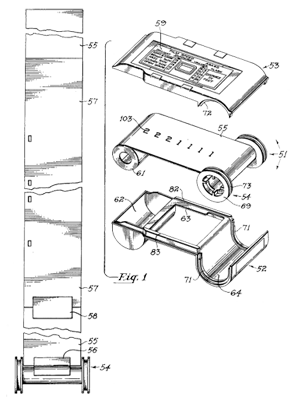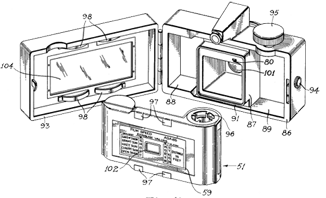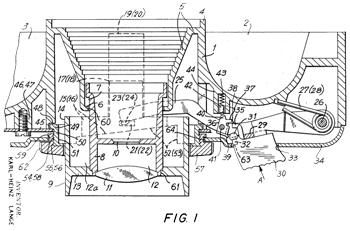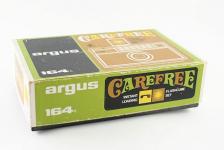|
Argus Instant Load 164 |
Manufactured or assembled in Germany from (Circa) 1967 to (After) 1967.
Index of rarity in France: Rare (among non-specialized garage sales)
Inventory number: 7262
See the complete technical specifications
Chronology of cameras Argus
This low-end Argus is adorned with a fake cell. It has no adjustments and does not accept 160 ASA film.
Film advancement is done through a wheel located on the back. The manual specifies that this operation rotates the flash.
The two batteries are intended to power the Flashcube for approximately 500 flashes. Attention: to change them, you need to open the film compartment! Plan ahead!
It was manufactured in Germany by Balda. Only the facade distinguishes it from the Balda 104.
The Argus Instant Load 164 is presented in a cardboard box that includes the camera, a film, a flash cube, a wrist strap, two batteries, and the user manual. This presentation is then referred to as the Argus 164 K (Kit!).

Balda followed Kodak in the path of the 126 and released a whole range of cameras using the new film cartridge.
Film and 126 Camera
 The patent 3,138,081 was published on June 23, 1964. It was filed by Kodak, and the inventor's name is Hubert Nerwin.
The patent 3,138,081 was published on June 23, 1964. It was filed by Kodak, and the inventor's name is Hubert Nerwin.
It involves a 35mm film contained within a closed cassette. Asymmetric, it serves both as a supply spool and a take-up spool. There is no possibility of inserting the film the wrong way in the camera due to its design. The film is perforated on one side only. The back is lined with paper bearing a frame number, employing the principle of an unexposed back on cameras to avoid the need for a mechanical frame counter. The camera only requires one drive spindle since there's no need to rewind the film. The cassette is returned to the Kodak laboratory after the final exposure without any additional handling.
With this innovative system, the photographer no longer runs the risk of mispositioning the film start tab or tearing the perforations. Also known as Kodapak, the 126 film was available in 20, later in 24 exposures (the 12-exposure version existed for a short time), either in color negative or for colour slides.

 The shape of the cameras changed during the series' existence. The shutter release of the early models is integrated into the front face and is black (Design 1).
The shape of the cameras changed during the series' existence. The shutter release of the early models is integrated into the front face and is black (Design 1).Later, it is larger and forms the top and left edge of the front face (Design 2).
The most advanced models change in design. The lens is retractable (Design 3). The mechanism for the movement of the lens was the subject of several patents filed in 1971 by Balda. The inventor was Karl-Heinz Lange (US3709129 and DE2136183).
| Years | Lens | Shutter | Design | Misc. | ||
| Models using Flashcube | ||||||
| 104 |  |
c.1968 | Fixfocus | Single speed | 1 | Winding knob. No setup. Fake cell |
| 304 | c. 1968 | Fixfocus | 1/60 | 1 | Like 104, but automatic exposure | |
| 544 electronic | c.1972 | Fixfocus | 18 to 1/250 | 1 | CdS cell | |
| 644 electronic | c.1972 | Symbols | 18 to 1/250 | 1 (?) | CdS cell | |
| 144 |  |
c.1971-77 | Fixfocus | Single speed | 2 | Winding knob. No setup |
| 344 | c.1972 | Fixfocus | 2 | Like 144, but automatic exposure | ||
| 844 electronic | 1971-77 | 18 to 1/300 | 3 | CdS cell, Light signals in the viewfinder. Retractable lens | ||
| Models using Magicube | ||||||
| 144-X |  |
1971-77 | Fixfocus | Single speed | 2 | Winding knob. No setup |
| 344-X | c. 1972 | Fixfocus | 2 | Like 144-X, but automatic exposure | ||
| 824-X | c. 1974-77 | 1/40 and 1/125 | 3 | Collimated viewfinder. Retractable lens | ||
| 834-X | c.1974-77 | 3 | Lights in the viewfinder indicating the setting (sun, shade, or flash). Retractable lens | |||
| 844-X electronic | c.1972-77 | 18 to 1/300 | 3 | CdS cell, Light signals in the viewfinder. Retractable lens | ||
| 944-X electronic | c.1974-77 | Isconar 5.6/35 Fixfocus | 8 to 1/1000 | 3 | CdS cell. Retractable lens | |
Interesting links or bibliography :
 |
Add a link or element of bibliography, a picture taken with this camera, a picture of box or an ads about this camera
Your photos taken with the same camera:
Cameras from Ebay France (Argus) (Uploaded each 3 hours)
 Argus. Étui en cuir pour appareil photo. Bon état, avec courroie 20,00 euros Finira le 04-05-2024 à 13:40:42 |  APPAREIL PHOTO ARGENTIQUE 24 X36 ARGUS 2 B ART DECO USA 59,00 euros Finira le 04-05-2024 à 19:58:01 |








